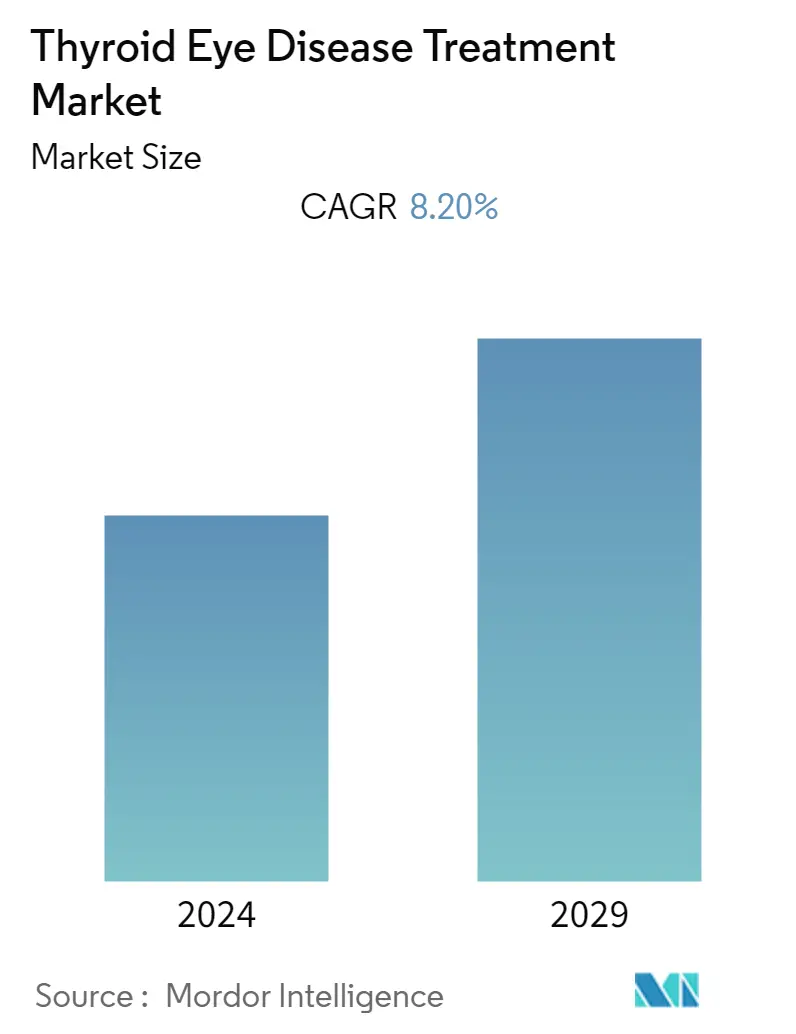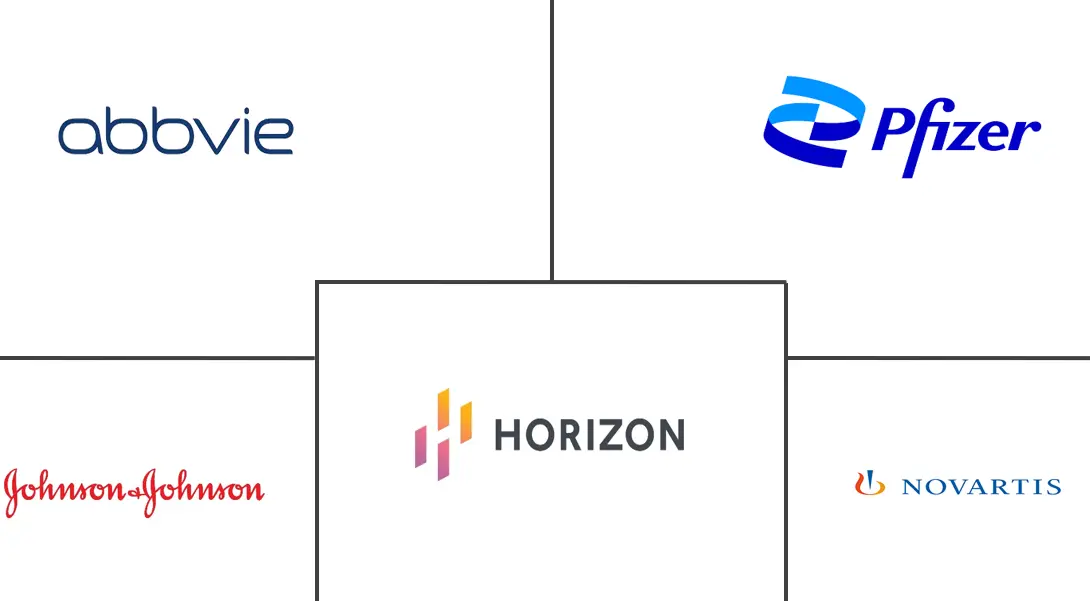Market Size of Thyroid Eye Disease Treatment Industry

| Study Period | 2019 - 2029 |
| Base Year For Estimation | 2023 |
| Forecast Data Period | 2024 - 2029 |
| CAGR | 8.20 % |
| Fastest Growing Market | Asia-Pacific |
| Largest Market | North America |
Major Players
*Disclaimer: Major Players sorted in no particular order |
Thyroid Eye Disease Treatment Market Analysis
According to the NCBI, thyroid eye disease is a complex inflammatory disorder of the eye orbit, which includes the orbital fibroblasts, adipocytes, extra-ocular muscles, optic nerve, and orbital vasculature. Systemic thyroid status can unpredictably affect the course of thyroid eye disease. The thyroid eye disease treatment market is expected to register a CAGR of 8.2% over the forecast period.
The COVID-19 pandemic negatively impacted the studied market due to delayed treatment and lack of diagnosis. According to the NCBI data published in February 2022, there is a possible risk of reactivation of autoimmune disease after COVID-19 vaccination. Certain autoimmune disorders, such as myasthenia gravis, new-onset of Graves disease, and subacute thyroiditis, were also developed among individuals who took COVID-19 vaccinations. Thus, there was a slight increase in the number of thyroid eye diseases during COVID-19, demanding treatment. Post-pandemic, the market has regained its importance.
The rising incidence of thyroid disease and increasing treatment options are among the significant factors driving the market's growth. Data published by NCBI in May 2021 states that the prevalence of TED is 40% in patients with Graves disease. Around 70% of the patients with Graves hyperthyroidism have subclinical extra-ocular muscle enlargement annually. This elevates the need for thyroid eye disease treatment, thereby contributing to market growth.
Similarly, the data updated by the American Academy of Ophthalmology in March 2020 stated that thyroid eye disease is most frequently associated with hyperthyroidism (consisting of 90% of cases). This factor points toward escalating demand for various treatment options to treat TED, as it can lead to visual disfigurement and disability and, in some cases, can cause permanent visual loss.
Moreover, according to a study by Biomed Central Ltd, published in September 2020, the global prevalence of patients with thyroid eye disease was around 10.36% for hypothyroidism, 7.9% for euthyroidism, and 86.2% for hyperthyroidism. Therefore, the increasing prevalence of thyroid eye disease among individuals is elevating the growth of the market globally and is expected to increase in the future, thereby driving the development of the studied market over the forecast period.
Owing to the aforementioned factors, the studied market is anticipated to witness growth over the analysis period. However, low awareness and underdiagnosis of thyroid disorders will likely impede the market growth.
Thyroid Eye Disease Treatment Industry Segmentation
Thyroid eye disease is a condition in which the eye muscles, eyelids, fatty tissues, and tear glands get inflamed. This condition causes the eyelids and eyes to become red and swollen. It causes discomfort in the eyes, pushing them forward.
The Thyroid Eye Disease Treatment Market is Segmented by Treatment Type (Monoclonal Antibody, Steroids, Artificial Tear Drops, and Other Treatment Types), Distribution Channel (Retail Pharmacy, Hospital Pharmacy, and E-commerce), and Geography (North America, Europe, Asia-Pacific, Middle East and Africa, and South America). The market report also covers the estimated market sizes and trends for 17 different countries across major regions globally. The report offers the value (in USD million) for the above segments.
| By Treatment Type | |
| Monoclonal Antibody | |
| Steroids | |
| Artificial Tear Drops | |
| Other Treatment Types |
| By Distribution Channel | |
| Retail Pharmacy | |
| Hospital Pharmacy | |
| E-commerce |
| By Geography | |
| North America | |
| Europe | |
| Asia-Pacific | |
| Middle East and Africa | |
| South America |
Thyroid Eye Disease Treatment Market Size Summary
The thyroid eye disease treatment market is poised for significant growth, driven by the increasing prevalence of thyroid disorders and the development of advanced treatment options. This complex inflammatory condition affects various components of the eye orbit and is often associated with hyperthyroidism, which accounts for a majority of cases. The market's expansion is supported by the rising incidence of thyroid eye disease, particularly among patients with Graves disease, and the growing demand for effective treatments to prevent visual disfigurement and disability. Despite the challenges posed by the COVID-19 pandemic, which led to delayed diagnoses and treatments, the market has rebounded, with monoclonal antibodies like Tocilizumab gaining popularity for their long-term therapeutic benefits.
North America is expected to dominate the thyroid eye disease treatment market, fueled by a high prevalence of the condition and the presence of key market players. The region's growth is further bolstered by regulatory approvals and product launches, such as the FDA's approval of TEPEZZA, the first drug specifically for this condition. The competitive landscape is characterized by a mix of international and regional companies, including Horizon Therapeutics PLC, Pfizer Inc., and Novartis AG, which are actively contributing to market dynamics. As awareness and diagnosis improve, the market is anticipated to continue its upward trajectory, despite potential challenges related to low awareness and underdiagnosis of thyroid disorders.
Thyroid Eye Disease Treatment Market Size - Table of Contents
-
1. MARKET DYNAMICS
-
1.1 Market Overview
-
1.2 Market Drivers
-
1.2.1 Rising Incidence of Thyroid Disease
-
1.2.2 Increasing Treatment Options for TED
-
-
1.3 Market Restraints
-
1.3.1 Low Awareness and Under-diagnosis of Thyroid Disorders
-
-
1.4 Industry Attractiveness - Porter's Five Forces Analysis
-
1.4.1 Threat of New Entrants
-
1.4.2 Bargaining Power of Buyers
-
1.4.3 Bargaining Power of Suppliers
-
1.4.4 Threat of Substitute Products
-
1.4.5 Intensity of Competitive Rivalry
-
-
-
2. MARKET SEGMENTATION (Market Size by Value - USD million)
-
2.1 By Treatment Type
-
2.1.1 Monoclonal Antibody
-
2.1.2 Steroids
-
2.1.3 Artificial Tear Drops
-
2.1.4 Other Treatment Types
-
-
2.2 By Distribution Channel
-
2.2.1 Retail Pharmacy
-
2.2.2 Hospital Pharmacy
-
2.2.3 E-commerce
-
-
2.3 By Geography
-
2.3.1 North America
-
2.3.2 Europe
-
2.3.3 Asia-Pacific
-
2.3.4 Middle East and Africa
-
2.3.5 South America
-
-
Thyroid Eye Disease Treatment Market Size FAQs
What is the current Thyroid Eye Disease Treatment Market size?
The Thyroid Eye Disease Treatment Market is projected to register a CAGR of 8.20% during the forecast period (2024-2029)
Who are the key players in Thyroid Eye Disease Treatment Market?
Horizon Therapeutics plc, Pfizer Inc., Novartis AG, Johnson & Johnson Services, Inc. (Johnson & Johnson Vision Care, Inc.) and AbbVie Inc. are the major companies operating in the Thyroid Eye Disease Treatment Market.

